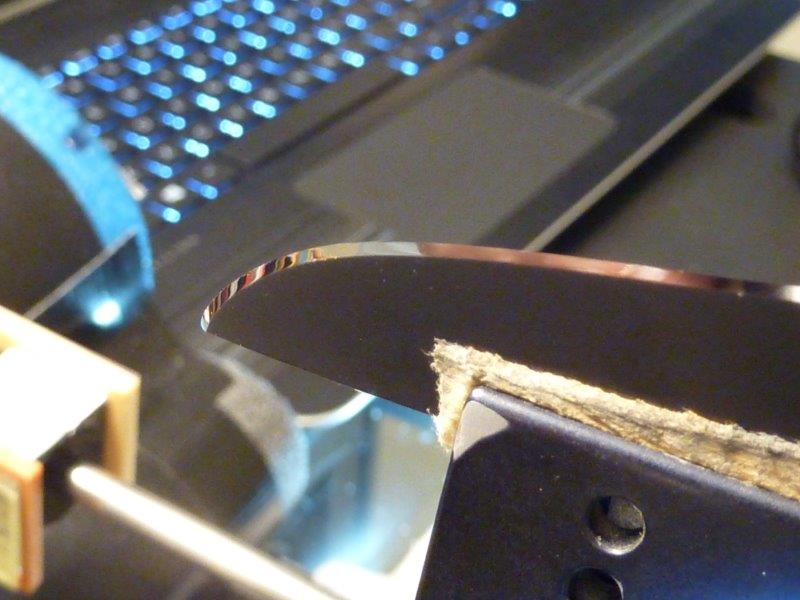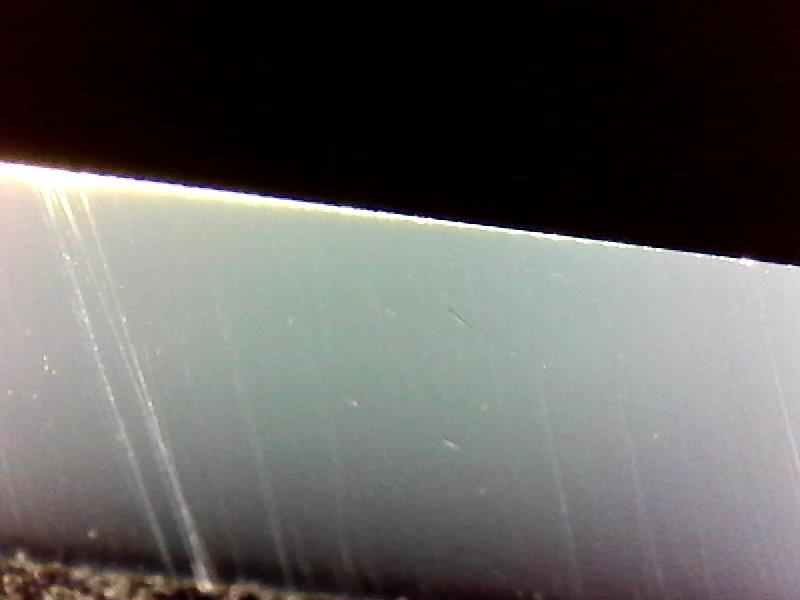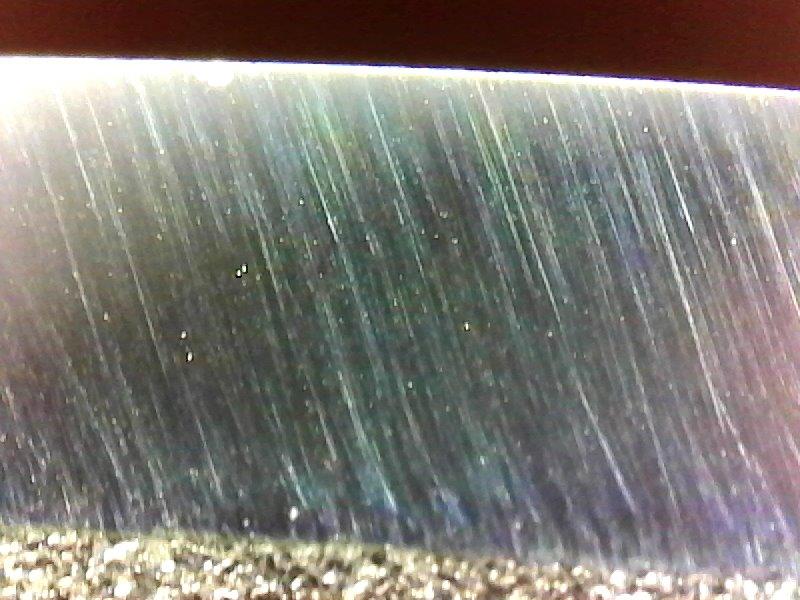Need Help with Basics of Using Lapping Film
Recent › Forums › Main Forum › Techniques and Sharpening Strategies › Advanced Techniques and Sharpening Strategies › Need Help with Basics of Using Lapping Film
- This topic has 114 replies, 12 voices, and was last updated 08/27/2017 at 11:32 am by
sksharp.
-
AuthorPosts
-
07/03/2017 at 6:46 pm #39849
I’ve had glass platens and lapping film for a while now and have only dabbled with it enough to know it can give me an incredibly scary sharp edge. I picked them up again today intent on truly learning how to get good results with the film.
I did compare the Aluminum Oxide Films with the Diamond Films and I believe the Diamond cuts better and easier then the Aluminum, (particularly on hard steels) when comparing equal grits and applying similar pressure.
Now I feel I have gained enough experience using the films to ask some questions of those of you with real experience using the lapping film.
What kind of pressure do you apply using with the films? I believe I got the best results with super light pressure. Certainly the film will last longer like that.
When is the optimum time to switch to using lapping films? In Clay’s video he progressed form 1000 grit Diamond Stones to 6 micron Diamond Film. Is there any advantage to taking the edge to a higher finer grit before switching to the film? Such as 6k or 8k Waterstones?
Should I expect to see the scratches diminish or fade as I progress through to the finer films, like I do using other media? I was making good progress through the 1.0 micron film. The bevel was getting cleaner and clearer with less and less scratches and the edge was incredibly sharp. I thought I was seeing this trend until I reached the 0.5 micron in the progression (9, 6, 3, 1.5, 1.0, 0.5, 0.1). When I started with the 0.5 diamond film I saw a lot of very fine unexpected scratches appear, (visually inspecting my progress using the USB microscope). These fine scratches seemed to increase as I continued using the 0.5 film. I finally just moved on to the 0.1 micron Diamond Film to see what would happen and got more very fine scratches. Any ideas or guesses on what I saw and why. The edge was still incredibly scary sharp, so no complaints there. The bevel even with the very fine scratches was still mirror reflective.
For those of you who have posted the great pictures showing the mirror polished knives, how does that super polished bevel appear under the microscope? Do you have fine scratches or is it clear of these?
Any help with technique specific to using Lapping Film and your experiences are greatly appreciated.
Marc
Marc
(MarcH's Rack-Its)07/04/2017 at 10:11 am #39851I’ve had similar results with film and was not sure if I was causing the scratches or if the polished bevels were just making them more obvious. I began to alternate directions with each grit progression and it became apparent that the scratches were new and not from an earlier grit. This is, of course, confirmed by your observation that you continued to produce more scratches with the same grit. Logic says that the scratches are produced by some contaminate which has embedded itself in the soft surface of the film.
One important point you didn’t mention was whether or not the scratches appeared on both sides and did they appear to be consistent. If so, then it is less likely that the scratches are from contaminates.
If it’s clear that the scratches are caused by contaminates, what to do? As soon as you notice the scratches appearing, stop polishing and try to scrub the contaminates away from the surface of the film. Alcohol works great for releasing the swarf from the film, but probably won’t remove embedded contaminates with a little scrubbing with your finger. That might require a somewhat more vigorous scrubbing (still with alcohol). I haven’t tried it yet, but a while back I bought a battery-powered scrubber which has some impressive power. Since the brushes are plastic, I would hope it wouldn’t damage the film. It’s the equivalent of an industrial version of my Oral-B toothbrush. You can find it here.
This assumes that the film is relatively new, and you’d like to save it. If you’ve done more than a few knives with the film, it might just be easier to change the film and get it over with. Which is what I’ve been doing. Next time I notice the scratches appearing, I’ll try to save the film with the scrubber, if only to test the idea.
1 user thanked author for this post.
07/04/2017 at 11:31 am #39852Good questions Tom. The film was fresh, new and never used. I did clean the glass before applying the new film. The scratches are bilateral so that throws out the contamination theory. Just to note, the bevel is still highly reflective and incredibly sharp even though there are numerous very fine scratches.
Thanks, and Happy Holiday to All
Marc
(MarcH's Rack-Its)07/05/2017 at 9:51 am #39862Marc: Can you post a photo taken with your USB ‘scope?
Your post implies that there were no noticeable (or significant) scratches when you were at 1.0 micron and that they suddenly appear when you’ve gone to 0.5 micron film. Is this true? Is the scratch pattern relatively uniform? Or is it more scattered? What does it look like after a single stroke?
I’ve frequently seen scratches that seem to appear at some grit level, but I’ve always assumed they were from an earlier grit which were made more apparent by the more highly polished background. Now I wonder if they’re just evidence of defective film.
07/05/2017 at 10:07 am #39865Now I wonder if they’re just evidence of defective film.
I’m wondering the same thing??
Tom, I’m doing a SOG Twitch II now and taking USB photos along the way. I’m working with 6 micron Diamond Film now. I’ll put something together and try to find the USB photos from the earlier attempt and post it later. I’m going to use the same questionable films and if I get similar results maybe I can try a fresh piece from the other end of the sheet.
Thanks, Marc
Marc
(MarcH's Rack-Its)07/05/2017 at 1:04 pm #3986707/05/2017 at 2:01 pm #39869Pinkfloyd, I just progressed up to the 0.5 micron Diamond Film on this knife I’m working on and it feels quite dry and dragging. I was wondering if I misted it with water it may help. Your suggestion confirms my thought. I always put a few drops of dish soap in my little mister bottle as I fill it. I’m gonna give it a try. Thanks
Tom, I’m again, seeing the bilateral straight scratches with the same piece of 0.5 film, I was using earlier. I did cleaned it with alcohol. I decided to continue to use this same piece of film a while longer to try to determine if the scratches are underlying, previous grit, scratches that are just finally coming to the surface. If the scratches diminish then we know that’s what it is. If they don’t then I’ll move on with a new piece of 0.5 micron film and compare the results. I am collecting USB microscope photos as I go along.
Marc
(MarcH's Rack-Its)1 user thanked author for this post.
07/05/2017 at 3:10 pm #39872MarcH – try changing direction with the film to see what happens w/ the scratches.
-Clay
07/05/2017 at 3:36 pm #39873MarcH – try changing direction with the film to see what happens w/ the scratches.
Hey Clay, I flipped the paddles over end for end, then switched them side for side. The scratches seemed to stay in a relatively vertical pattern, (perpendicular to the bevel edge). It’s not a scattered, random scratch pattern. The scratches didn’t seem to diminish as I continued to put the time in and work on them. Then I figured before I changed the film itself and possibly waste a piece, first, I’d back down to 6 micron, again, and polish again with an edge trailing stroke but at a different angle then previously done. This time more horizontal from heel to tip and less vertical, straight up and off. I plan to repeat the progression trying to vary the up and away stroke direction just enough to see if what I had were previous underlying scratches left from previous grits in the progression. The scratches may be left from the wetstones I used before switching to the film. When I get back down to the 0.5 micron, again, I’ll see what I’ve got. Then I can decide if I need to change out the 0.5 micron film depending on my results. It may be a badly manufactured batch like Tom suggested. I thought I needed to eliminate poor, not thorough technique from the equation, first.
This is just one of my EDC knives I’m messing with to learn good technique to using the lapping films. So there’s no hurry to getting it done. Just something I’m messing around with.
Thanks all,
Marc
Marc
(MarcH's Rack-Its)07/05/2017 at 4:29 pm #39874Try resting the paddles all the way down on the rod ends and moving the films parallel to the edge without ever lifting the paddles so that you get a horizontal scratch pattern. Once you’ve eliminated all the vertical scratches and have only horizontal ones, then clean the films off and make some vertical strokes, lifting the paddles and see what kind of scratches you get.
-Clay
07/05/2017 at 6:03 pm #39875Try resting the paddles all the way down on the rod ends and moving the films parallel to the edge without ever lifting the paddles so that you get a horizontal scratch pattern. Once you’ve eliminated all the vertical scratches and have only horizontal ones, then clean the films off and make some vertical strokes, lifting the paddles and see what kind of scratches you get.
Thanks, that’s essentially what I was trying to achieve. I thought if I slid the film up slightly as I moved down the bevel length I would have less of a chance to cut the film then strictly sliding it horizontally. I’ll try your suggestion. Thanks.
Marc
(MarcH's Rack-Its)1 user thanked author for this post.
07/06/2017 at 1:05 am #39882I have no advice to add, but still want to let you know I find this an interesting subject. I think it would really help if you could post some microscope picture (200x or higher) of the results of the 1 diamond film and the 0.5 mu diamond film (and possible the 0.1 mu diamond film). I might give some advice then, too.
Molecule Polishing: my blog about sharpening with the Wicked Edge
07/06/2017 at 9:46 am #39890I’ll attempt to post the USB Microscope Photos taken under high power (believe it’s 250X):
Backround: This knife is a SOG Twitch II, AUS-8 Steel. I began the touch up with Shapton Glass Wetstone 500 grit >> Shapton Glass Wetstone 1000 grit>>followed Diamond Lapping Film progression (9µ, 6µ, 3µ, 1.5µ, then, 1.0µ). To this point everything looked great.
Here is Knife Photos of the clamped reflective bevel:
Here is the USB Microscope of the bevel take after finishing with the 1.0µ DLF;
I’ll post the 0.5µ DLF USB Photos in the next post.
Marc
(MarcH's Rack-Its)Attachments:
You must be logged in to access attached files.
1 user thanked author for this post.
07/06/2017 at 9:56 am #39894This is 0.5µ DLF under 250X USB Microscope. First I did edge trailing, up and away strokes, the I followed Clays suggestion to leave the stone bottomed and slide the film horizontally across the bevel:
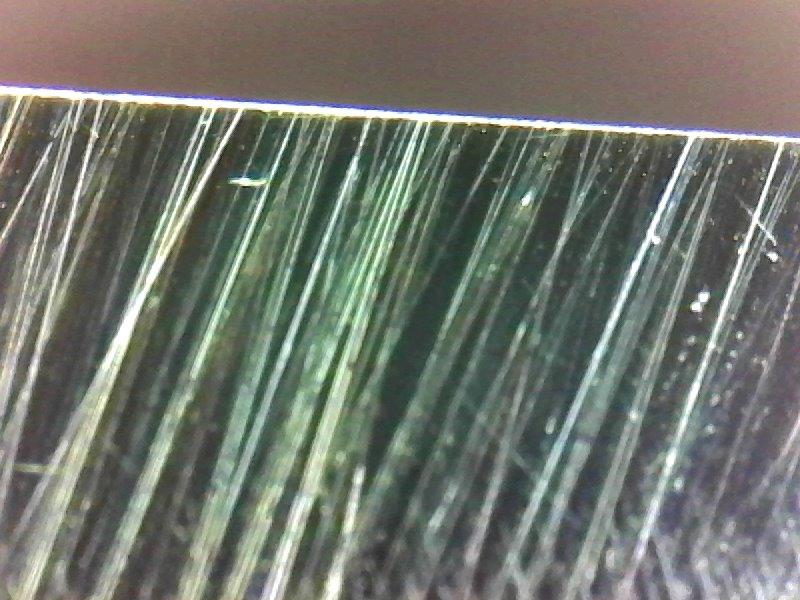
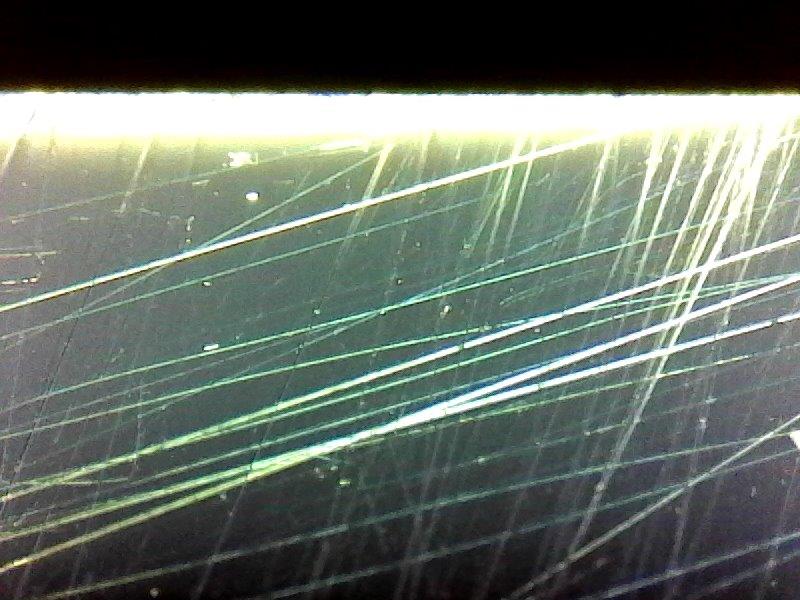
You can see the scratch patter changes direction in the second photo.These photos were taken after I went back to the beginning and started over with 500 grit, then 1000 grit Shaptons Glass Stones then followed the diamond film progression (9, 6, 3, 1.5, 1.0) again, this time being deliberate to try to insure I have removed all previous scratches left from previous grits. The results and photo results are the same. I also used a new piece of film removed from the opposite end of the sheet from the first piece I had selected. My conclusions are either I expect too much, or the film is inconsistent in the manufacturing, or I some how have contaminated the one grit film.
Thanks, Marc
Marc
(MarcH's Rack-Its)Attachments:
You must be logged in to access attached files.
1 user thanked author for this post.
07/06/2017 at 10:01 am #39897Last I wanted to post this photo of the very fine scratches still visible on the highly polished, highly reflective bevel:
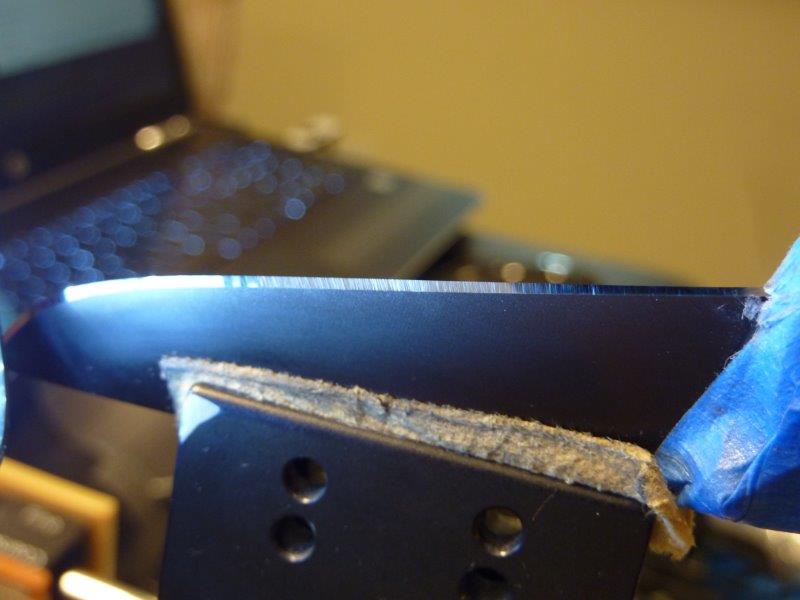
If I was to focus on the reflection these scratches aren’t apparent.Marc
(MarcH's Rack-Its)Attachments:
You must be logged in to access attached files.
-
AuthorPosts
- You must be logged in to reply to this topic.
